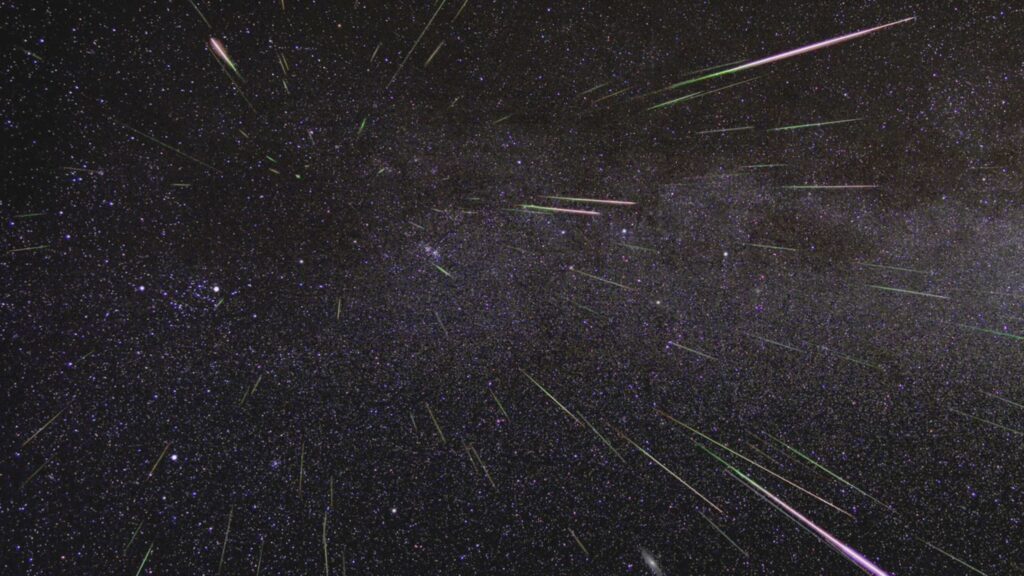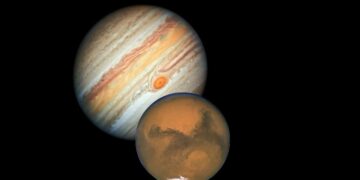In an event that has both casual stargazers and seasoned astronomers buzzing with excitement, Mars and Jupiter are set to dazzle the night sky in their closest conjunction in a decade. On August 14, 2024, these two planets will appear to almost touch, creating a striking visual spectacle that won’t happen again until December 2033.
This celestial event, known as a planetary conjunction, is more than just a pretty sight; it’s a reminder of the intricate ballet performed by the planets in our solar system. The conjunction occurs when Mars and Jupiter align with Earth in such a way that they appear exceptionally close together from our perspective. Although the planets will seem nearly side by side, they are actually separated by more than 350 million miles (575 million kilometers) in space.
The best views of this conjunction will be in the pre-dawn hours, with Mars and Jupiter rising together in the eastern sky. This will be a rare opportunity to see two of our solar system’s most iconic planets in such proximity, and it’s an event that requires no special equipment—just a clear sky and a view to the east.
While these conjunctions happen approximately every three years, this particular event is special because of how close the planets will appear. The last time Mars and Jupiter were this close was in 2018, and they won’t get this cozy again until 2033. The conjunction is not just a visual trick; it’s a product of the orbital mechanics that govern our solar system. As Mars, Jupiter, and Earth align, the planets appear to converge, although they are still vast distances apart.
The closest approach during this event will be about 0.3 degrees apart—less than the width of a full moon in the sky. To put it into perspective, you could fit just a sliver of the moon between them. This type of alignment is what astronomers refer to as an “illusion of coming together,” where the planets seem to nearly overlap when viewed from Earth.
Beyond its visual appeal, the Mars-Jupiter conjunction is a fascinating event that highlights the precision of celestial mechanics. These predictable alignments allow astronomers to study the dynamics of planetary orbits and refine models that predict future conjunctions and other celestial events. It’s also a perfect example of how celestial phenomena can be both scientifically significant and accessible to the general public.
Additionally, this conjunction coincides with the Perseid meteor shower, one of the year’s most anticipated meteor showers. The convergence of these two events provides a unique opportunity for skywatchers to witness multiple celestial wonders in a single night. The Perseids, known for their bright, fast meteors, will peak just a few days before the conjunction, making the mid-August skies particularly eventful.

To best view the Mars-Jupiter conjunction, find a location with an unobstructed view of the eastern horizon. The planets will rise a few hours before sunrise, so the early morning is the best time to catch the show. While no binoculars or telescopes are necessary, they can enhance the view, especially in clearer conditions.
As you prepare to witness this rare event, remember that you’re observing a phenomenon that won’t occur again for nearly a decade. The alignment of Mars and Jupiter is a reminder of the dynamic and ever-changing nature of our universe, a spectacle that blends beauty with the intricate workings of our solar system.
This conjunction, like many celestial events, serves as an invitation to pause and look up, to marvel at the universe’s grand design, and to consider our place within it. Whether you’re a seasoned astronomer or a curious observer, this Mars-Jupiter conjunction offers a rare and memorable opportunity to connect with the cosmos.
For more information and skywatching tips, you can explore resources from [NASA](https://science.nasa.gov/skywatching/)



















